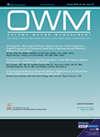一项评估瑞典患者造口术后1年适应性的前瞻性探索性研究。
摘要
造口手术改变了一个人的生活。为了评估造口术后1年的生活适应和生活质量(QOL),在瑞典一所大学医院造口门诊的患者中进行了一项前瞻性探索性研究。所有连续接受非紧急或紧急手术的患者,包括造口术的形成,并在第一年接受肠造口治疗师(ET)在病房和门诊诊所的定期随访,前瞻性地纳入研究;他们的人口统计信息(包括年龄、性别、造口的诊断/原因、非紧急或紧急手术、造口类型、术前咨询/坐位[是/否]、造口护理的自给自足、专业活动以及他们是否与配偶/伴侣生活在一起)在进入研究时被记录下来。参与者独立完成造口调整量表(OAS),这是一个36项的工具,每个回答从最差到最佳调整(1到6)得分,总分从36-216。该工具涉及5个因素:正常功能、功能限制、负面影响、积极角色功能和积极影响。此外,使用视觉模拟量表(0至100毫米)以及2个开放式生活质量问题来评估生活质量。定量和定性数据包括在同一份问卷中,并由2名研究人员输入Excel文件。定量数据移入统计软件进行分析;根据Graneheim和Lundman对定性数据进行分析。定量数据采用描述性统计并基于非参数分析,定性数据采用内容分析。在符合纳入条件的150例患者中(82例女性,68例男性,中位年龄70[21-90]岁),110例(73%)接受了非紧急手术,106例(71%)接受了结肠造口术,44例(29%)接受了回肠造口术。大多数造口术是由于癌症(98.65%)和炎症性肠病(28.19%)造成的,90%的参与者在造口护理方面是自给自足的。OAS的总中位数得分为162,性别和诊断之间没有显著差异。术前接受ET咨询的患者与未接受ET咨询的患者的OAS评分分别为163分和150分(P = .313)。癌症和回肠造口术患者的平均OAS评分为136,癌症和结肠造口术患者的平均OAS评分为163。在正常功能因子方面,癌症合并回造口患者的调整(平均3.6±1.32)明显低于癌症合并结肠造口患者(平均4.4±1.21)(P = 0.015)。最低的调整分数是在性活动和吸引力以及参加体育运动和体育活动方面;得分最高的是与ET接触,感觉信息灵通,以及知道正确的处理造口术的方法。所有患者生活质量的中位评分为76分(四分位数范围为59-86)。定性内容分析中出现了三(3)类障碍:造口相关的担忧和对生活的影响,身体和社会活动的限制,以及对身心健康的负面影响。我们发现ET在教育和咨询方面有重要的作用,以促进造口术患者从术前到随访的生活适应。未来的探索性研究需要确定患者希望如何设计关于性和敏感问题的问题,以及ET如何最好地讨论造口手术后的性和亲密关系。Having ostomy surgery changes a person's life. To assess adjustment to life with an ostomy and quality of life (QOL) 1 year after ostomy surgery, a prospective, explorative study was conducted among patients of a stoma clinic at a university hospital in Sweden. All consecutive patients who had undergone nonemergent or emergency surgery involving formation of an ostomy and who received regular follow-up at the ward and at the outpatient clinic during the first year by an enterostomal therapist (ET) were prospectively included in the study; their demographic information (including age, gender, diagnosis/reason for an ostomy, nonemergent or emergency surgery, ostomy type, preoperative counselling/siting [Yes/No], self-sufficiency in stoma care, professional activity, and whether they lived with a spouse/partner) was recorded upon admission to the study. Participants independently completed the Ostomy Adjustment Scale (OAS), a 36-item instrument, with each response scored from worst to best adjustment (1 to 6) for a total score ranging from 36-216. The tool addresses 5 factors: normal functioning, functional limitations, negative affect, positive role function, and positive affect. In addition, QOL was assessed using a visual analogue scale (0 to 100 mm) along with 2 open-ended QOL questions. Quantitative and qualitative data were included on the same questionnaire and were entered into an Excel file by 2 of the researchers. The quantitative data were transferred to statistical software for analysis; the qualitative data were analyzed according to Graneheim and Lundman. Descriptive statistics were used for quantitative data and based on nonparametric analysis, and qualitative data were analyzed using content analysis. Of the 150 patients eligible for inclusion (82 women, 68 men, median age 70 [range 21-90] years), 110 (73%) underwent nonemergent surgery, 106 (71%) had a colostomy, and 44 (29%) had an ileostomy. Most ostomies were created due to cancer (98, 65%) and inflammatory bowel disease (28, 19%), and 90% of participants were self-sufficient in ostomy care. The overall median score on the OAS was 162 with no significant differences between genders and diagnoses. The OAS scores for patients who did versus did not have preoperative counselling by an ET were 163 and 150, respectively (P = .313). Mean OAS scores were 136 for patients with cancer and an ileostomy and 163 for patients with cancer and a colostomy. Patients with cancer and an ileostomy had a significantly worse adjustment (mean 3.6 ± 1.32) than patients with cancer and a colostomy (mean 4.4 ± 1.21) in the factor Normal function (P = .015). Lowest adjustment scores were in the areas of sexual activities and attractiveness and participating in sports and physical activities; the highest scores concerned contact with an ET, feeling well informed, and knowing the correct methods of handling the ostomy. The median score for QOL for all patients was 76 (interquartile range 59-86). Three (3) categories emerged from the qualitative content analysis as obstacles to QOL: ostomy-related concerns and impact on life, limitations in physical and social activities, and negative impact on physical and mental health. The ET was found to have an important role in education and counselling to promote adjustment to life with an ostomy from preoperative to follow-up care. Future explorative studies are needed to determine how patients want questions about sex and sensitive issues to be designed and how the ET can best discuss sexuality and intimacy after ostomy surgery.

 求助内容:
求助内容: 应助结果提醒方式:
应助结果提醒方式:


